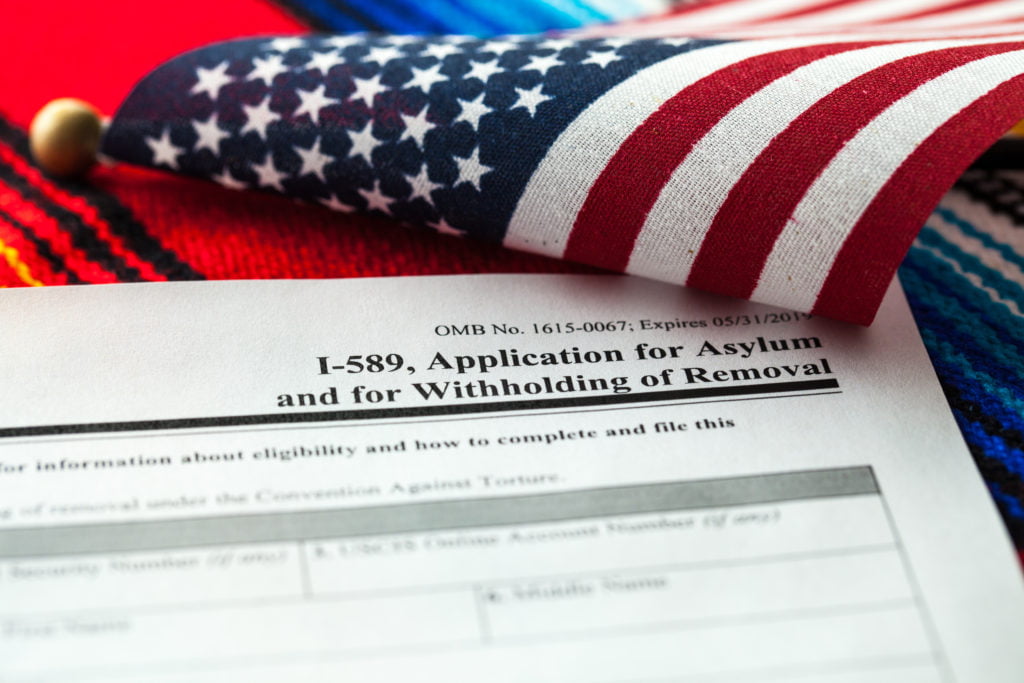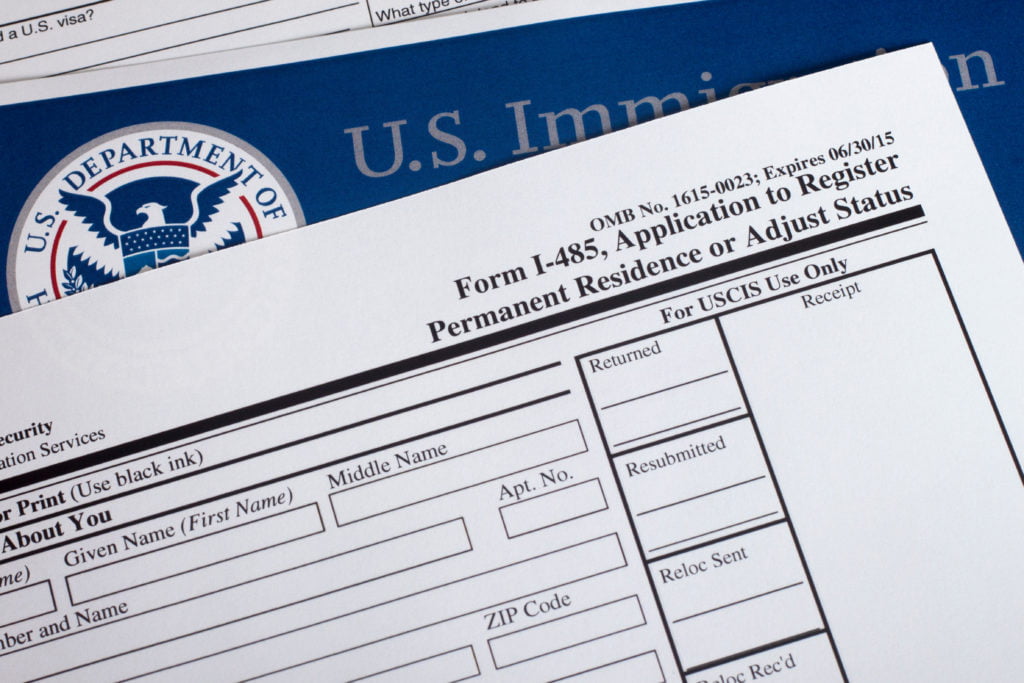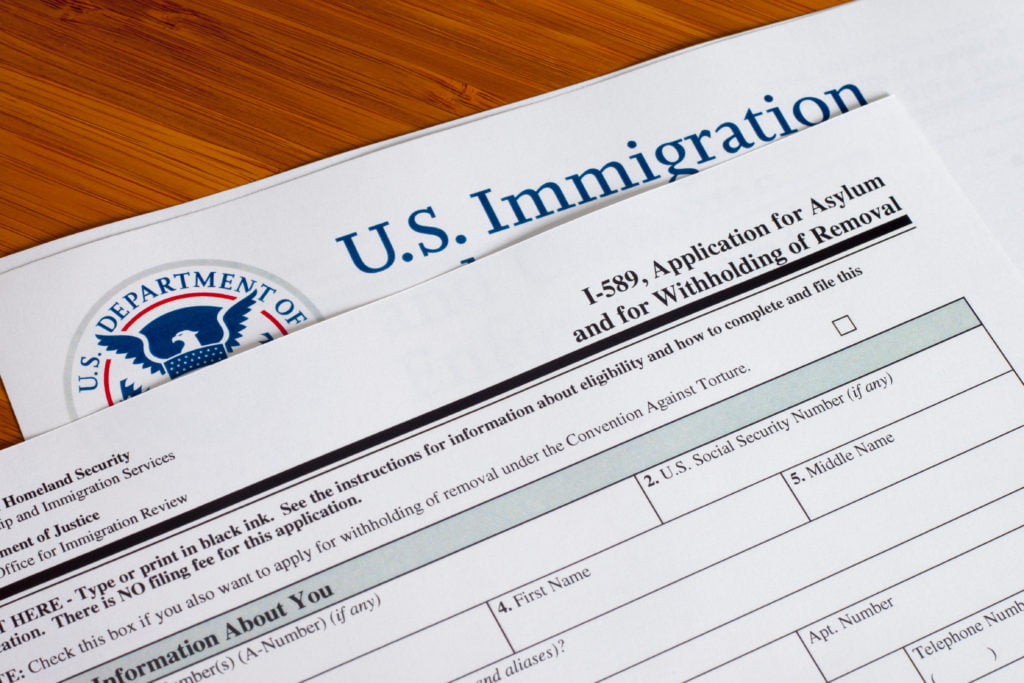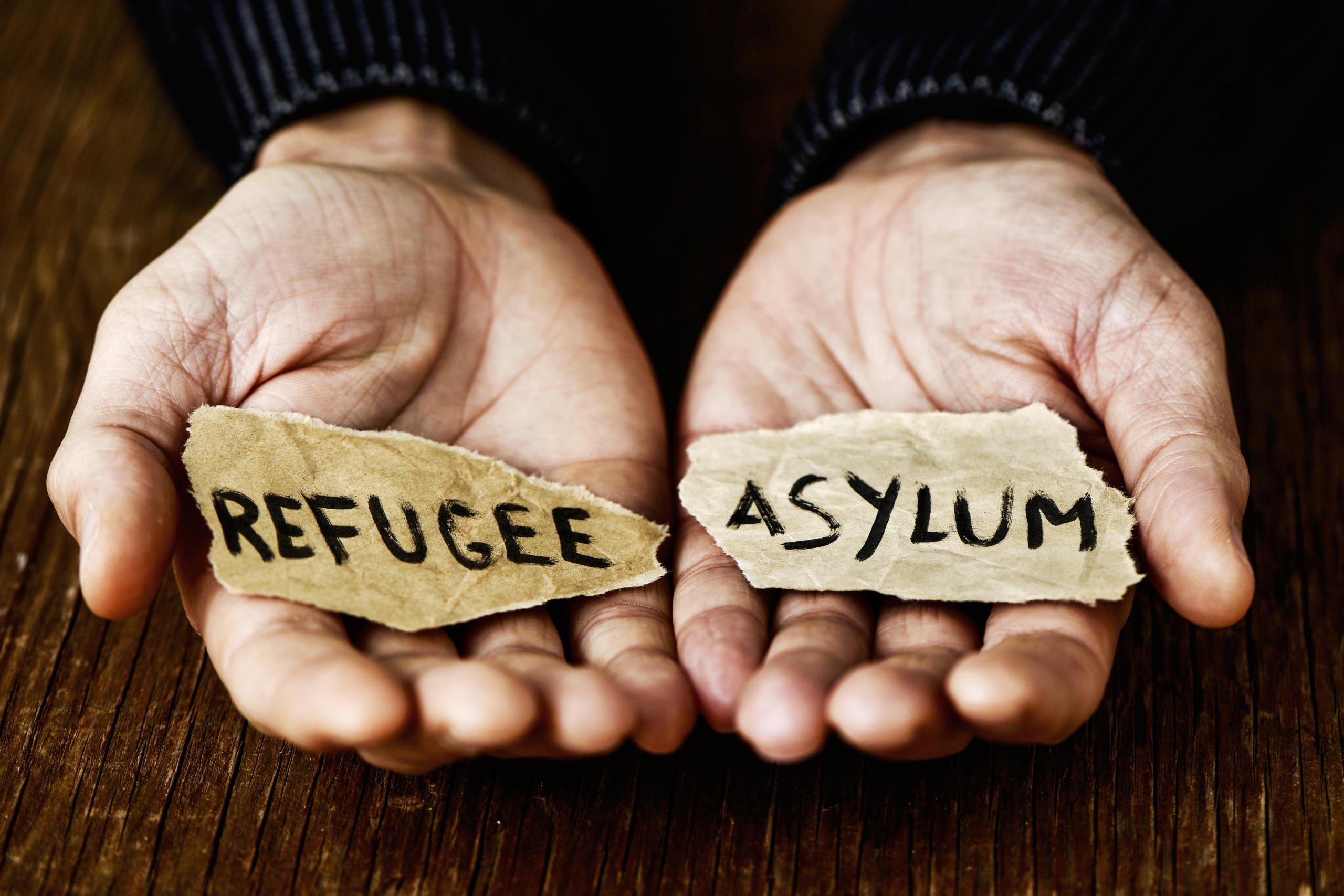Generally speaking, the following 7 steps are how to apply for asylum in the United States:
- Arrive in the U.S. at any border or port of entry
- Apply for asylum (application packets include documents like the I-589 form, ID copies, personal statement, etc.)
- Undergo fingerprinting and background/security checks
- Receive a notice for the scheduled asylum interview
- Interview with an immigration officer and present your case
- Wait for the asylum officer to determine eligibility
- Return to the asylum office after a couple of weeks to pick up the decision/ruling or wait for the decision by mail.
Note: there will be a longer wait time to hear a final decision if the application is still being processed or if the applicant is subject to enhanced background screening.
To be eligible for asylum status, foreign nationals must also show proof of the following:
- Persecution based on race, religion, political opinion, nationality, or membership in a particular social group.
- A valid fear of returning to their home country because of the personally targeted threats or oppression they have endured. Persecution may include, but is not limited to forced abortions or sterilization, torture, or other threats of bodily harm.
- And/or a substantial fear of future persecution.
If you have any questions about applying for asylum or would like to learn more, visit our asylum overview page on our website.

United States Asylum Overview
Asylum is a type of protection the United States government grants foreign nationals to legally remain in the U.S., so long as they are: already in the U.S. (or arriving at a U.S. port of entry), and are eligible for “refugee” status, as defined by international law. Fortunately for refuge seekers, this means the United States government has a legal obligation to provide protection to those who qualify. Such status is reserved for individuals with a credible fear of persecution in their home country.
As defined in the United Nations 1951 Convention and in the 1967 Protocol, a refugee is someone who is unwilling, and ultimately unable to return to their home country. It is someone who cannot obtain any type of protection in their country due to either past persecution, or a reasonable fear of future persecution, “on account of race, religion, nationality, membership in a particular social group, or political opinion.” This definition was incorporated into United States immigration law, in the Refugee Act of 1980, established by the United States Congress.
Furthermore, there are two paths to obtaining refugee status, as established by the Refugee Act: from within the United States as an asylum seeker, or from outside of the U.S. as a relocated refugee. Asylees apply to permanently reside in the U.S., navigate the path to gain American citizenship and oftentimes apply for their family (spouse and children) to join them in the United States.
Seeking refugee or asylum status can get quite complicated, as oftentimes there are more than one federal agency involved. Additionally, there are two types of asylum application processes to understand: affirmative and defensive.
Affirmative vs. Defensive Asylum Processes
Affirmative Asylum
The affirmative asylum process refers to when a foreign national is currently in the United States, applies for asylum within one year of their date of entry and is not in any removal proceedings. Such application and requisite documents are sent to the U.S. Citizenship and Immigration Services (USCIS) for review. Subsequently, the USCIS will require a copy of fingerprints and an interview with the applicant in order to determine whether they are eligible for protection via asylum status.
If at any point during this evaluation the USCIS decides they are unable to arrive at a conclusion, the case is referred to immigration court. There, the applicant appears before an immigration judge to present their case. If the officer does not believe you have a significant possibility of making a successful asylum case, you will be deported from the U.S. If you believe you do have a good case, you can ask an immigration judge to have a look at your circumstances. If a judge does so, he or she will make their final decision within seven days. If the judge agrees with the asylum officer, removed from the U.S., and it is impossible to appeal the judge's decision. If the judge does not agree with the officer’s decision, and believes there is a possibility you could make a successful asylum case, you will be granted another opportunity for an immigration court hearing. It is important to note, sometimes this will be in front of a different judge.
Alternatively, if the asylum seeker has a U.S. visa, including but not limited to a: student, employment or visitor, then the USCIS will reject the application, and the asylum seeker must leave the country by the time their visa expires.
As previously mentioned, there is a strict deadline of one year past an applicant’s date of arrival for the application to be filed. If the asylum seeker attempts to apply after one year, they must give proper evidence that an “extraordinary circumstance” directly caused their delayed application, and that they did not cause such circumstance.
If the asylum seeker is married and/or has children (unmarried and under the age of 21) who are in the U.S. with the applicant, he or she simply needs to include their information on his or her application at the time they file. While it is not recommended to wait, there is an option to add the information at any time while the application is being processed by a USCIS officer.

Defensive Asylum
The defensive asylum process is when an applicant is currently in removal proceedings. Meaning, the individual does not carry any legal status in the United States, or has otherwise done something to invalidate legal immigration status. Consequently, he or she appears before an immigration judge who ultimately rules whether the applicant is permitted to stay in the U.S. At this point, the USCIS has no involvement in the asylum case.
Likewise, upon arrival to United States ports of entry, asylum seekers who have a substantial fear of persecution in his or her home country inform border officials of their wish to seek asylum. An officer will conduct an interview to assess whether the individual has a credible fear of returning to their home country.
Upon the successful passing of such an interview, the applicant will submit the required documentation along with the Form I-589, Application for Asylum for Withholding of Removal. After this screening, the petitioner goes through the process of defensive asylum in immigration court.
Unlike refugees, asylees must apply for employment authorization upon asylum application approval. There are, however, certain circumstances where asylees can apply for a work permit while their application is being processed. Asylees may apply for a legal permanent status (a green card) one year after their application approval, and after four years they can apply for American citizenship.
Required documents for both types of processes:
- 2 sets of the asylum application, called Form I-589 (the original you filled out, plus one copy)
- 1 recent passport-size photograph of you and your spouse and/or your children
- 2 copies your passport
- 2 copies of any U.S. immigration documents, such as your I-94 Arrival/Departure Record
- 2 copies of other identification documents, such as birth certificate, national identity card or driver's license
The following are not mandatory, but will strengthen your asylum case:
- A cover letter, detailing the contents of the application (mention any special requests here)
- 1 original and 1 copy of your declaration (otherwise known as personal statement)
- 1 original and 1 copy of declarations from friends or family who have witnessed how you were harmed or threatened in your home country
- 1 original and 1 copy of an expert declaration from a medical expert who has examined you for evidence of physical abuse you have suffered in your home country
- 1 original and 1 copy of an expert declaration from a psychologist or psychiatrist who has examined you for evidence of emotional problems you suffer as a result of harm inflicted upon you in your country
- 1 original and 1 copy of an expert declaration from a human rights activist or an academic who is familiar with human rights abuses in your country
- 1 original and 1 copy of any country conditions reports and/or news articles explaining human rights abuses in your country and what has happened to you specifically
- Any other materials which confirm what happened to you in your home country, including photographs showing how you were harmed, threatening letters, newspaper articles describing how you were harmed, official government documents, etc.
When researching about how to apply for asylum in the United States, keep documentation in mind. It is important asylum applicants make and retain additional copies of all documents for their own records.

Difference Between Asylee and Refugee
Although many people use the two terms interchangeably, and though there are many similarities, asylee and refugee statuses are different. One of the main differences is where the individual is when they apply for asylum. If an applicant is not in the United States, they would be considered a refugee. Conversely, if the applicant is currently in the U.S., (port of entry or border) they would be considered an asylee.
According to the U.S. Immigration and Nationality Act (INA), a refugee, is “...any person who is outside any country of such person's nationality or, in the case of a person having no nationality, is outside any country in which such person last habitually resided, and who is unable or unwilling to return to, and is unable or unwilling to avail himself or herself of the protection of, that country because of persecution or a well-founded fear of persecution on account of race, religion, nationality, membership in a particular social group, or political opinion…” Furthermore, the INA addresses the following scenarios: a woman who has been forced to abort a pregnancy, undergo involuntary sterilization, refuses such procedures, or has otherwise resisted a “coercive population control program” is considered to have a “well-founded fear of persecution on account of political opinion.” The U.S. Refugee Admissions Program (USRAP) has established a priority in processing cases for individuals of special humanitarian concerns to the United States. As such, top priority (otherwise known as P-1) is
assigned to individuals who have been referred by the United Nations High Commission on Refugees (UNHCR), by a U.S. Embassy, or by any other certain non-governmental organizations.
The second priority (P-2) cases relate to groups of special humanitarian concern, while third priority (P-3) cases are for family reunification.
Individuals with any of the three aforementioned priorities, first go through a pre-screening process, through a Resettlement Support Center. Then, an interview with a USCIS officer, several security checks and a medical exam used to determine whether the applicant is eligible for immigration in the United States as a refugee.
Upon approval, the refuge seeker is assigned to a resettlement agency sponsor who will assist the refugee in finding housing and employment upon arrival to the U.S. After one year of entry, refugees can apply for a green card, and after four years of retaining such green card, they can apply to become a citizen of the United States.
Like asylees, refugees have the right to remain in the U.S. indefinitely, and/or until it is safe for them to return to their home country, though a safe return is quite impossible for either refuge seeker.
Asylum Eligibility
After having lived in a state of constant fear, asylum seekers must prove they have a valid fear of returning to their home country - for reasons of past or imminent persecution based on religion, political opinion, membership in a particular social group, or even their race or nationality. Such oppression must be inflicted by the government, or by a group the government cannot control, and ultimately will not or does not govern. Furthermore, the individual must show they would face the same persecution in any part of their country, even if they relocated. They must demonstrate the proof they were personally targeted and would not be safe, no matter where they go (in their home country.)
To further qualify examples of targeted harm or oppression, the following instances indicate validity.
The individual has experienced, has undergone or has a fear thereof:
- "Coercive population control programs,” such as forced abortion or sterilization
- Death threats
- Torture
- Imprisonment
- Constant surveillance
- Pressure to join a group which engages in illegal activities
- Interference with their privacy, family, home
- Correspondence, or discrimination in matters of housing, education or passport issuance
While the presence of poor economic conditions, crime, conflict, social unrest, lack of financial opportunities, or other hardships are strong examples of inferiority, the government simply cannot grant protection via asylum.

Asylum Helps People Fleeing Persecution
Quite importantly, anyone granted asylum (an asylee) is protected from being removed, deported or otherwise returned to their country of origin. Asylees receive employment authorization to work legally in the United States, and can apply for a Social Security card. They are able to request and obtain permission to travel abroad without fear of being denied when returning back to the U.S. border. Asylees can petition or request to bring their family members to the U.S. – for reunification and protection purposes. Asylees are even eligible for government programs, such as Refugee Medical Assistance and Medicaid.
After the individual has had asylum status for one full year, the asylee can apply for lawful permanent resident status as well as receive their green card. Once the individual becomes a permanent resident for four years, he or she is now able to apply for citizenship.
These are some vital examples of how asylum (and refugee) status helps people escaping severe, personally-targeted oppression, though there are a plethora of programs and organizations dedicated to their cause.
Other Protection and Convention Against Torture (CAT)
Asylees set out to secure a long-term solution to their catastrophic hardships. Fortunately, the United States government offers protection to refugees and asylees which entail many aspects. Such protection includes safety and prevention of being returned to danger, access to an efficient and fair asylum procedure, as well as extensive measures taken to ensure their basic human rights are fully respected.
Even if an asylum seeker does not qualify for asylum status, he or she may still be eligible for Withholding of Removal from the United States. If the applicant is granted Withholding of Removal, they are not eligible to receive a green card. They can, however, be granted permission to lawfully remain and work in the United States. In order to be granted Withholding of Removal, the applicant must demonstrate extraordinary likelihood they will suffer future persecution if they are returned to their country of origin. Again, this would be due to the applicant’s race, religion, nationality, membership in a particular social group, or political opinion. The precedent of the standard set for Withholding of Removal is higher than for asylum approval, meaning the applicant must prove there is more than a 50 percent chance they will be persecuted if returned to their home country.
If an asylum seeker fears torture in their country of origin, he or she may qualify for relief under the Convention Against Torture (CAT). Such relief will be successfully granted, provided the following proof is present: the applicant must prove they are more likely than not to either be tortured directly by their government or tortured with the consent (or “acquiescence”) of the government, if returned to their home country. Acquiescence generally refers to when a government is aware of the torture inflicted upon the applicant, but does not actively, nor passively try to prevent it such torture. Relief under CAT is a protection granted by an immigration judge which prevents deportation of individuals who have a high possibility of being tortured in their home country.
Frequently Asked Questions About How To Apply For Asylum In The United States
What does asylum mean?
In the context of immigration, the term ‘asylum’ refers to the protection offered by a country or state to a severely oppressed individual. Such protection is granted to a refugee who has either left their home country, or has a substantial fear of returning - because they have suffered persecution, or are afraid of future persecution based on their race, religion, political opinion, or membership in a particular organization.
What is the difference between “asylee” and “refugee?”
An asylee is one who applies for asylum while in the United States, while a refugee is one who applies from outside.
Valid scenarios for applying for asylum in the United States
Scenarios are mainly limited to the following: a valid fear of returning to one’s home country, because of past or future persecution, based on race, religion, nationality, political opinion, or membership in a particular social group. This oppression must be directly inflicted by the government, or by a group the government cannot or will not control.
Who can apply for asylum in the US?
Any individual is eligible to apply, provided they meet the following criteria:
He or she must have been persecuted in the past, or have a substantial fear of future persecution. Furthermore, this persecution must be from the applicant’s home country’s government, or from a group the government cannot or will not control. Lastly, the persecution reasoning must be because of the following: race, religion, nationality, membership in a particular social group, or a particular political opinion.
How can I apply for asylum in the United States?
Please see more information under the affirmative and defensive asylum section above, as the application process depends on whether the applicant is currently in removal proceedings.
When can I apply for asylum?
Asylum seekers can apply for asylum after they have entered the United States.
Where can I apply for asylum?
While inside the United States, or at any U.S. border or port of entry.
What should be included in my asylum application?
While the I-589 asylum application includes detailed instructions, explaining what is required when applying for asylum, additional documents should be included to help strengthen your case. Other than the I-589 application itself, they are as follows: a personal statement, as much supporting evidence as possible, a legal argument written by your attorney (if applicable), and a detailed section titled, “Country Conditions.”
How long does an asylum application take to be processed?
The initial asylum application process is quite lengthy, and can take several weeks, months and sometimes even a few years, depending on the amount of applications received in any given geographic location. It is important for you to prepare yourself for a potentially long waiting period for your case to be heard, and ultimately decided.
Are there any background, criminal or security checks for asylum?
Yes, these are all requirements, and are the first steps in the immigration process. Asylees and refugees alike must pass all biographic security checks.
Am I required to submit my fingerprints while applying for asylum?
Yes, fingerprints are a required step while applying for asylum status in the United States.
How much does it cost to get my fingerprints scanned for an asylum application?
There are no fees associated with asylum applications, including fingerprint scans.
Which documents do I need when applying for asylum?
Asylum application (I-589), passport-size photo, copy of passport, copies of U.S. immigration documents, (I-94 Arrival/Departure Record, etc.), copies of such as birth certificate, national identity card or driver's license, or any other identification
Can I apply for asylum while I am in the United States?
Yes, this is where asylum cases begin.
Can I apply for asylum outside of the United States?
No, this would be refugee status, not asylum.
How much does it cost to apply for asylum?
The USCIS does not charge a fee for applying for asylum.
Can I apply for asylum if I am undocumented?
Yes, even if you are an undocumented asylum applicant, you may apply for asylum - provided you are not in any removal proceedings.
Can I apply for asylum if I was convicted of a crime?
Yes. However, you must disclose all details related to each crime on your application and during your interview. If you have a criminal background, it is important to note there are certain types of crimes which will prevent you from obtaining legal asylum. For more information, please contact an experienced immigration attorney.
For disqualifications, read more here.
What will be my status after I am granted asylum?
Your status will be asylee until you apply for, and are granted, United States citizenship.
How do I know if my application for asylum is approved?
Upon approval of your asylum application, you will receive an approval notice, as well as your I-94 card which will be stamped "asylum granted indefinitely."
How do I check the status of my asylum application?
To check on the status of your U.S. asylum application, enter your receipt number here.
I was granted asylum status, can I bring my family?
Yes. After you’ve been granted asylum, and assuming your spouse and qualifying children aren’t currently with you in the United States, you may file an I-730 petition.
My asylum application was denied. Can I reapply?
The U.S. consular officer has the ultimate authority to make decisions regarding nonimmigrant visa applications. Even though the officer denied your application, you are permitted to ask them to explain why. You cannot reapply, however you can apply for a waiver.
If my asylum application is approved, will I have to renew?
No. If your application is approved, you will receive an approval notice, along with your I-94 card stamped, "asylum granted indefinitely." As you are now living in the U.S. with asylee status, you can apply for a Social Security Number and legally work without needing a work permit.
I have an interview for my asylum case, what if I need to reschedule it?
Two possible outcomes are likely to happen. The first being, if you wait more than 45 days to reschedule, your case will be effectively referred to an immigration judge. The second being, the Asylum Office will close the case and send you a notice of “Dismissal of Asylum Application.” The interview with an asylum officer is an extremely important step in becoming an asylee, or legal immigrant in the United States.
Do I need an immigration attorney when I apply for asylum?
No. It is not required, however the likelihood of winning your case is considerably higher if an immigration lawyer is involved.
Do I need an immigration attorney when I apply for asylum?
No. It is not required, however the likelihood of winning your case is considerably higher if an immigration lawyer is involved.

